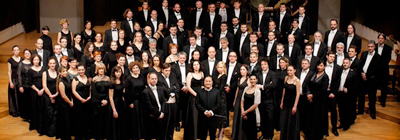by Daniel Hathaway

The 91-year-old Belgrade orchestra has made a remarkable recovery from the chaos and economic privations of the wars in the Balkans of the 1990s. Having rebuilt itself as an ensemble with an average age of 40, the BPO is now keen on building a new concert hall with the help of the American Friends of the Belgrade Philharmonic Orchestra foundation, the major agenda for their October tour.
Though Severance Hall was far from sold-out on Tuesday, it was clear that many Clevelanders of Serbian descent turned out to applaud (after each movement!) and cheer for a plucky and accomplished ensemble who simply played their hearts out in music by Aram Khachaturian, Stevan Hristić and Jean Sibelius.
Following greetings from the local committee, the BPO performed both The Star-Spangled Banner and the Serbian national song with the help of an unidentified, uniformed brass band. Then Tang and the ensemble immediately showed visceral exuberance in the five dances that make up Khachaturian’s 1944 Masquerade suite. Their rich, colorful sound wasn’t always finely blended, but was stunning in its vigor. A big, plummy trumpet solo and braying trombones were very much in the Balkan brass band tradition. A fine clarinet cadenza and excellent articulation distinguished the wind playing. Orchestra players are known to move in their chairs while performing, but many of the Belgrade musicians swayed like snake charmers.
The orchestra’s huge, dark tone was also evident in Suite No. 1 from The Legend of Ohrid, completed in 1947 by the ensemble’s founding conductor, Stevan Hristić. Serbian, Greek and Janissary dances preceded Turtle-Dove and visited a wide range of styles from the raucous and syncopated to the atmospheric — solos by flutes, harp, oboes and clarinets over shimmering string textures.
Sibelius’s second symphony, conceived on a large scale in every way, followed intermission. The surging strings at the beginning were outsized, the sound of the horns was immense, and the wind entrances in the third movement were explosive. It was exciting, to be sure, but too many loud and opaque climaxes piled one upon the other and —unrelieved by more subtle playing — eventually grew tiresome.
Tang, who was a kinetic presence on the podium all evening, leapt into the orchestra and wandered about during the BPO’s first encore, Glinka’s Ruslan and Ludmila Overture. A Serbian march (familiar to anyone who follows the Serbian Hour on FM 90.3) wrapped up the concert in a further blaze of ethnic glory.
Published on ClevelandClassical.com October 13, 2014.
Click here for a printable copy of this article.


